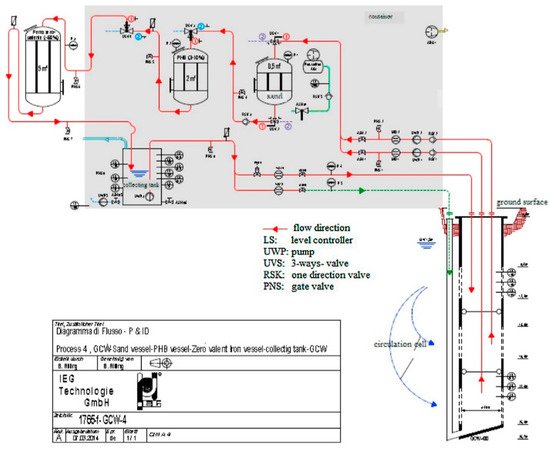Chlorinated aliphatic hydrocarbons (CAHs) are ubiquitous contaminants whose presence in groundwater has persisted for many decades, mainly due to the physical-chemical characteristics of these compounds. In particular, CAHs belong to Dense Non-Aqueous Phase Liquids (DNAPLs), for which contamination scenarios differ significantly from Light NAPLs scenarios, where the separate phase floats at the top of the water table due to its lower density than water.
- bioremediation
- biological reductive dechlorination
- chlorinated aliphatic hydrocarbons
- sustainable materials
- biochar
- polyhydroxyalkanoates
- bioelectrochemical systems
1. Background
Chlorinated aliphatic hydrocarbons (CAHs) are ubiquitous contaminants whose presence in groundwater has persisted for many decades, mainly due to the physical-chemical characteristics of these compounds [1][2][1,2]. In particular, CAHs belong to Dense Non-Aqueous Phase Liquids (DNAPLs), for which contamination scenarios differ significantly from Light NAPLs scenarios, where the separate phase floats at the top of the water table due to its lower density than water [3][4][3,4].
The two major problems associated with aged CAHs-contaminated sites are the secondary source management and the containment and remediation of the contamination plume. Secondary source refers to the presence of the solvent in a separate phase, primarily accumulated in the low-permeability layers of the aquifer (clay lens), which work as a source of long-term contaminants [5]. On the other hand, contamination plume refers to prolonged contamination in the same direction of water flow due to the slow and steady release of secondary sources. The distribution of contaminants is highly dependent on the hydrogeological characteristics of the site and concentration levels differing greatly from source to source.
Today, in-situ technologies can operate and significantly reduce costs, although detailed site characterization is required. In this context, many improvements have been made in modeling and interpreting the data to support the design and adoption of the right strategy [6]. For the remediation of chlorinated solvents plume, the In-Situ Bioremediation (ISB) technologies are growing attention. The reasons for the success are the public support, success on the dissolved contaminants, and a comparatively low cost when it is effective [7]. If the presence of degradation intermediates is detected during site characterization, the biological Natural Attenuation phenomenon occurs due to the presence of specific microorganisms [8]. For the reductive dechlorination (RD) of widespread contaminants, such as tetrachloroethane (TeCA), perchloroethylene (PCE), and trichloroethylene (TCE), in an anaerobic environment, one of the most widely used approaches is enhanced natural attenuation (ENA) [9][10][9,10]. The intervention provides the addition of an organic fermentable substrate to produce short-chain fatty acids (acetate and other volatile fatty acids, VFAs) and the direct electron donor, the molecular hydrogen [11][12][11,12]. Therefore, almost any fermentable substrate can be a potential source of carbon and hydrogen to stimulate RD, including carbohydrates (sugars), alcohols, oils, solids (e.g., bark mulch, chitin), and complex compounds (e.g., whey and cellulose) [13]. The RD is a well-known, step-by-step reaction. Focusing on the sequential RD pathway of PCE through TCE, cis-dichloroethyene (cis-DCE), and vinil chloride (VC) to ethene, shown in Figure 1 , the efficiency of each step can be dramatically different depending on the environmental conditions and the microbial populations responsible for the reactions [14][15][14,15]. If the specific population has developed in the aquifer ( Dehalococcoides spp.) , the reaction may proceed until ethene production. As with every technology, serious issues may be associated with ISB, and the following situation may seriously affect meeting the remediation goals: Low efficacy on separate phase or highly adsorbed fraction (at source); Substrate availability limitations; and Incomplete degradation pathways (stall at an intermediate stage) for energetic and kinetic constraints with volatile and more toxic by-product accumulation, e.g., VC.

Recently, the combined approach has been investigated to help address the RD limits. Complete management of the site can be achieved more effectively with a combination of physicochemical processes to prompt anaerobic biodegradation [16]. For example, over the last few decades, the feasibility of DNAPLs’ bioremediation, also in the source areas, has been recognized through the combination of ISB with other more aggressive technologies, such as ISCO-R (In-Situ Chemical Oxidation Reduction), thermal treatment, and excavation [17]. In addition, the coupled technology is expected to be more satisfactory than a single-technology approach to deal with site changes and response during the intervention. Compared to individual methods, coupling technologies into sequences, combinations, or treatment trains can be more effective in reducing the contamination level and in the overall duration. As concerning the specific RD reactions, it is well known that the anaerobic condition favors the degradation of the highly chlorinated compounds, whereas aerobic condition favors the oxidation of di- and mono-substituted compounds [14]. For this reason, the sequential combination of technologies that might be considered opposing (reduction/oxidation) may be more effective to avoid VC accumulation.
2. Combination of GCW (Groundwater Circulation Well) and ENA (Enhanced Natural Attenuation)

